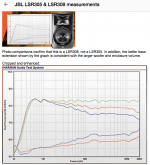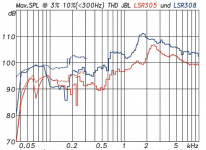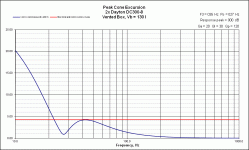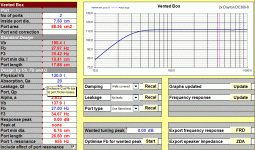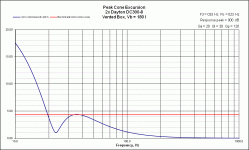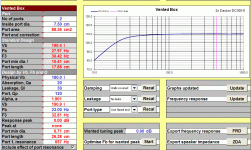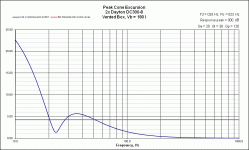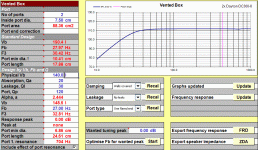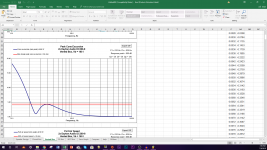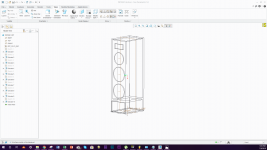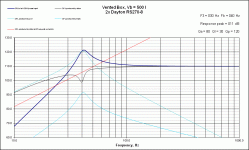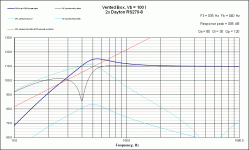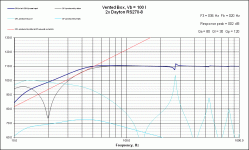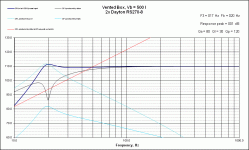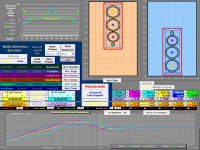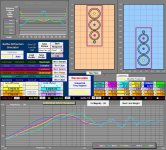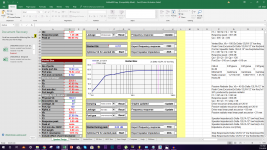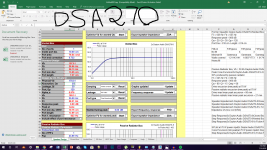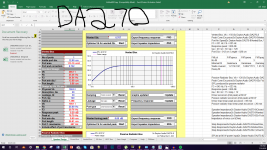Will,btw with an app on my phone, the current max volume that I play on my JBLs seem to be between 100 - 105dB. A change to 110dB doesn't seem that big...
haha it turns out that app was just way off, I tried a different app and said that the music was ~80dB. I have a future of music production and rely on music all the time and have
already killed many nerves in my ears but I will try to avoid going past 100dB with my DIY speakers. I think earbuds are more of a threat than speakers though.
Hard to put a meter inside your ear, but there are in ear monitors capable of in excess of 140 dB, dosn't take long to tear up your hearing at that level.
You now have two potentially wrong SPL readings, a dedicated dB meter should be on your birthday list. A phone app won't be accurate above around 110 dB SPL as the electret mic clips around that level, and can inflate levels above.
That said, at one meter, a single JBL LSR308 can put out around 112 dB at 1800 Hz, but only 98 dB at 50Hz at Xmax. That ain't going to get the 808 kick sample happening, but a pair of LSR308 have enough clean upper output to damage your hearing, the OSHA (Occupational Safety & Health Administration) limit is only 30 minutes a day for 110 dBA, (slow). The "A" scale rolls off at 1000 Hz, one can take far more LF (low frequency) level without hearing damage.
Not to dissuade you of building a full range speaker system, but what you are actually lacking presently is only low frequency- the LSR308 is around -8dB at 40 Hz, yet there is another full octave of bass in pop music missing below that!
If you built a subwoofer (or two, or four..) capable of flat response to 20 Hz your system could do justice to the music containing the lower octave frequencies. Without it, your mixes on your bass-deficient speakers will not translate well to systems that have extended response.
If you are serious about music production, your monitoring system should be too.
Your LSR308 use two separate 56 watt amplifiers to independently drive the 8" and tweeter, low frequencies will require a lot more power. Matching room response and proper integration between subs and tops would best be served with DSP, which could be also be used in any "full range" speakers you design.
At any rate, with your limited budget, putting the money towards what will make the most difference is something you may want to consider, especially since it will be hard to beat the LSR308, which have excellent polar response. Beefing up thier rattling back cover was a good suggestion, though ;^).
Cheers,
Art
Attachments
Last edited:
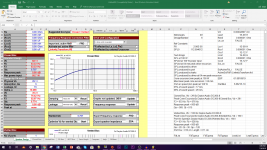 Doing stuff to Vb and F3 isn't changing the Vb in Standard Design tab. The only thing that changes that is "Vas" which i can't change because that is part of the speaker specs or whatever...
Doing stuff to Vb and F3 isn't changing the Vb in Standard Design tab. The only thing that changes that is "Vas" which i can't change because that is part of the speaker specs or whatever... Also which output am I supposed to check that doesn't exceed 4.3mm? I only see a Xmax input
I'm also confused with how I'm able to change the Fb freely, will this be something I follow up with when building the crossover? I put it to 27.97Hz which is what the red is in Standard Design.
Will,
Hard to put a meter inside your ear, but there are in ear monitors capable of in excess of 140 dB, dosn't take long to tear up your hearing at that level.
You now have two potentially wrong SPL readings, a dedicated dB meter should be on your birthday list. A phone app won't be accurate above around 110 dB SPL as the electret mic clips around that level, and can inflate levels above.
That said, at one meter, a single JBL LSR308 can put out around 112 dB at 1800 Hz, but only 98 dB at 50Hz at Xmax. That ain't going to get the 808 kick sample happening, but a pair of LSR308 have enough clean upper output to damage your hearing, the OSHA (Occupational Safety & Health Administration) limit is only 30 minutes a day for 110 dBA, (slow). The "A" scale rolls off at 1000 Hz, one can take far more LF (low frequency) level without hearing damage.
Not to dissuade you of building a full range speaker system, but what you are actually lacking presently is only low frequency- the LSR308 is around -8dB at 40 Hz, yet there is another full octave of bass in pop music missing below that!
If you built a subwoofer (or two, or four..) capable of flat response to 20 Hz your system could do justice to the music containing the lower octave frequencies. Without it, your mixes on your bass-deficient speakers will not translate well to systems that have extended response.
If you are serious about music production, your monitoring system should be too.
Your LSR308 use two separate 56 watt amplifiers to independently drive the 8" and tweeter, low frequencies will require a lot more power. Matching room response and proper integration between subs and tops would best be served with DSP, which could be also be used in any "full range" speakers you design.
At any rate, with your limited budget, putting the money towards what will make the most difference is something you may want to consider, especially since it will be hard to beat the LSR308, which have excellent polar response. Beefing up thier rattling back cover was a good suggestion, though ;^).
Cheers,
Art
Yeah I understand what your saying, I don't think I will need an SPL meter because I just wanted the main idea of the volume I am currently listening at. My weight workouts usually last 20 - 30 minutes and thats 4 time a week so I shouldn't be damaging my ears too much.
I know I can push the JBLs much louder but I want the bass so I stop at around 80dB for most songs, some I go below. In the future I might build some sub woofers for monitoring but I don't need really high volume for making beats. I also switch to headphones sometimes to make sure I'm choosing good sounds and the mix isn't to dead. When finishing a song I even test on my casual listening earbuds so getting an idea of what the mix sounds like isn't a big problem.
About building this DIY system its not all about just extending volume. It's mostly about the experience of building it and building what I want to build. Also learning and fun etc...
You should not be trying to changing anything in the Standard Design box. That is the calculated theoretical response based on the driver's TS parameters that will give the flattest response. It is just something to give you a frame of reference for your own design. The cells below the Standard Design are for your design and after you set the absorption, leakage and port parameters, Vb and Fb are about the only things left for you to work with.
First let's look below at the cone excursion for your last 180L design at 50W which shows that xmax was exceeded. Next 2 charts are the same design with 30W which now allows the cone movement to stay below xmax (for music above 20Hz). The max SPL is when xmax is not exceeded and so for this driver in this alignment that's going to be 110dB with 30W.
Now if you want a smaller box than that for whatever reason (less expensive, takes up less space, easier to move, etc) and aren't too concerned with loosing some SPL below 30Hz where there isn't very much musical content anyways (but occasionally with some types of music it is true that content below 30Hz is present), then let's try lowering Vb and raising Fb.
So try this:
1. lower Vb to 160L. (F3 is now about 35Hz which is too high)
2. so raise Fb to 25Hz (F3 is now back down to about 33Hz which works)
3. let's try Vb at 140L now (F3 goes back up to 35Hz, so...)
4. raise Fb to 27Hz (and F3 is back down to 33Hz which again looks good)
5. you can keep going with this pattern but 140L and 27Hz is about the best I could get to work.
6. now look at xmax. Because the driver doesn't quite have the LF extension as before, there is less cone excursion and so you can give it a little bit more power. 40W is now fine before xmax is exceeded. Max SPL is now 112dB. (Last 2 charts) I chose 2 x 3" diameter ports which work out to about 10.5" in length for that tuning. 1 x 4" port works as well.
As you go through this, maybe keep your eye on the port length. When I was starting out, I wished that I could change the port length and then see what that does to the response but the programs don't work that way. Instead you can only change the tuning frequency, Fb, and then the program calculates the port length needed to achieve that.
First let's look below at the cone excursion for your last 180L design at 50W which shows that xmax was exceeded. Next 2 charts are the same design with 30W which now allows the cone movement to stay below xmax (for music above 20Hz). The max SPL is when xmax is not exceeded and so for this driver in this alignment that's going to be 110dB with 30W.
Now if you want a smaller box than that for whatever reason (less expensive, takes up less space, easier to move, etc) and aren't too concerned with loosing some SPL below 30Hz where there isn't very much musical content anyways (but occasionally with some types of music it is true that content below 30Hz is present), then let's try lowering Vb and raising Fb.
So try this:
1. lower Vb to 160L. (F3 is now about 35Hz which is too high)
2. so raise Fb to 25Hz (F3 is now back down to about 33Hz which works)
3. let's try Vb at 140L now (F3 goes back up to 35Hz, so...)
4. raise Fb to 27Hz (and F3 is back down to 33Hz which again looks good)
5. you can keep going with this pattern but 140L and 27Hz is about the best I could get to work.
6. now look at xmax. Because the driver doesn't quite have the LF extension as before, there is less cone excursion and so you can give it a little bit more power. 40W is now fine before xmax is exceeded. Max SPL is now 112dB. (Last 2 charts) I chose 2 x 3" diameter ports which work out to about 10.5" in length for that tuning. 1 x 4" port works as well.
As you go through this, maybe keep your eye on the port length. When I was starting out, I wished that I could change the port length and then see what that does to the response but the programs don't work that way. Instead you can only change the tuning frequency, Fb, and then the program calculates the port length needed to achieve that.
Attachments
What shows that xmax is exceeded, how will I know?
And I know I can't change standard design but I was saying why am I able to freely change the Fb? Is this something I adjust to in the crossover, because everything else in the inputs I am in control of when I build the box...
Like when working with wood and insulation and those things I don't see how I would be doing anything with Hz.
And I know I can't change standard design but I was saying why am I able to freely change the Fb? Is this something I adjust to in the crossover, because everything else in the inputs I am in control of when I build the box...
Like when working with wood and insulation and those things I don't see how I would be doing anything with Hz.
What shows that xmax is exceeded, how will I know?
Look at the cone excursion charts above. The blue line is cone excursion at different frequencies. The red line is the driver's xmax. In chart 1, the blue line is above the red line - xmax is exceeded. In the other charts blue is only above red below 20Hz and 24Hz respectively, where there is rarely any musical content. If there is musical content in a song that is below those frequencies, then xmax will be exceeded then too.
And I know I can't change standard design but I was saying why am I able to freely change the Fb? Is this something I adjust to in the crossover, because everything else in the inputs I am in control of when I build the box...
Like when working with wood and insulation and those things I don't see how I would be doing anything with Hz.
Port length is responsible for the tuning frequency, Fb. It has nothing to do with the xo. If you lengthen the port and keep the box size the same, you lower the tuning. If you shorten the port, you raise the tuning. This is 1 way of fine tuning the vented response once you have everything built.
Re-read my last post - I just explained though that you can't change port length directly in box modeling programs. You have to change Fb, and then the program changes the port length for you.
Right, exactly. When the cone excursion looks like that, that will be the driver's max clean SPL. The driver can actually go louder than that and there is usually more mechanical cone excursion remaining, but the voice coil starts to go above and/or below the magnet and so the signal is no longer as faithfully reproduced. More distortion and compression in other words.
ok so,
the 315 can take 60w and is $76
The 300 can take 50w and is $40
everything else is pretty similar between the two. Would having the extra wattage be worth it?
the 315 can take 60w and is $76
The 300 can take 50w and is $40
everything else is pretty similar between the two. Would having the extra wattage be worth it?
It helps me to make a table thingy with the different drivers and with the significant parameters we are looking at. I had to go back and look to be sure.
SDA315-8 - max SPL of 114dB with 80W
DC300-8 - max SPL of 112dB with 40W
Sensitivity is about the same for the 2 drivers which means that they both need about the same power to achieve the same SPL, for eg, about 30W for 110dB. The SDA315 can just play louder if you want it to and you would therefore need a bigger amp for it.
Sound quality wise, I'll bet you are getting what you pay for here. But again, you don't have to make a decision yet. Let's expand the list. We've already seen that the DC250 won't play loud enough, so why don't you look at the smaller DSA270-8 next?
SDA315-8 - max SPL of 114dB with 80W
DC300-8 - max SPL of 112dB with 40W
Sensitivity is about the same for the 2 drivers which means that they both need about the same power to achieve the same SPL, for eg, about 30W for 110dB. The SDA315 can just play louder if you want it to and you would therefore need a bigger amp for it.
Sound quality wise, I'll bet you are getting what you pay for here. But again, you don't have to make a decision yet. Let's expand the list. We've already seen that the DC250 won't play loud enough, so why don't you look at the smaller DSA270-8 next?
stuffing the box with more and more absorption reduces the output from the vent until you pretty much just end up with something very close to the FR of a closed box of the given Vb. Make the comparison in the closed box section to see.
[...] Or if you want to change the response after the box is built, simply putting a bit of insulation right inside the port will do the same thing.
This is useful for:
1) 'fixing' cheap / awful bass from (undersized or badly made) ported boxes
2) turning small(ish) speaker into the satellite parts of a sat + sub-woofer system
It is literally the first thing I did to my cheap PA speakers, transforming them all the way from fairly bad to quite adequate 🙂
Unknown sensor in port
Not to dissuade you of building a full range speaker system, but what you are actually lacking presently is only low frequency
[...]
At any rate, with your limited budget, putting the money towards what will make the most difference is something you may want to consider, especially since it will be hard to beat the LSR308, which have excellent polar response. Beefing up thier rattling back cover was a good suggestion, though ;^).
This.
I know I can push the JBLs much louder but I want the bass so I stop at around 80dB for most songs, some I go below.
But that's exactly the point of Art's suggestion. If you use the JBLs as the top boxes and add bass boxes below, you won't have to stop at 80dB.
Going by the 2nd graph he attached in post 221, as a top box, it could easily get past 100dB without hitting the 3% distortion line. Having 15 or 20dB more headroom is HUGE.
About building this DIY system its not all about just extending volume. It's mostly about the experience of building it and building what I want to build. Also learning and fun etc...
You keep saying this (which is fine: it is a good motivation). But learning and DIY are not mutually exclusive with suggestions like this. I think the learning aspect & the final build quality could be better if you staged the project and/or base it on an existing product.
Simply put: if you break the project into parts, you'll have less to learn (and spend) at each stage.
e.g.
1) fix any rattles / defects in the JBLs.
That broad notch from 100-200Hz in Art's output vs distortion graph corresponds nicely with what was mentioned in the review I linked earlier: a back plate "rattling when 140-200hz is played". The deepest part of the notch is at ~160Hz. At this frequency, the system hits 3% distortion at only 85dB output. That's bad: it means the system is distortion limited to only 1 watt of input; the other 55 watts which the amp is capable of are going unused.
If fixing that back plate removes that 100-200Hz area, you'll have literally 10dB more output (at the same distortion level). If you can get that benefit from $5 of glue, that's a seriously good value upgrade.
2) DIY build just the 2x12" section of your DIY project. Run that as the bass box, with the JBL monitors as the tops.
3) research & buy parts for the next bit
4) DIY build a top box for your DIY project
5) return the JBL monitors to full range / nearfield use
Building the bass and top boxes separately can be a good idea for other reasons - especially if you'll ever have to move the system. Getting good portability and enclosure strength is easier with 2 enclosures than 1.
My JBLs have no defects and I don't want to mess with perfectly good speakers that play loud enough for making beats and mixing. I don't hear any distortion or rattling...
I feel like a young, immature brat just saying no to much more logical approaches to this but I simply want to build full speakers on their own. Increasing the bass and volume of the JBLs may be a future project but for now I am working on these as one fully working system.
I feel like a young, immature brat just saying no to much more logical approaches to this but I simply want to build full speakers on their own. Increasing the bass and volume of the JBLs may be a future project but for now I am working on these as one fully working system.
Last edited:
If you have to keep them to ~80dB, that's a defect.My JBLs have no defects
Read my last post again - by all means, build full speakers. I suggested that you use the JBLs as tops as an interim step, so you can build your project one part at a time: easier to learn and possibly easier to pay for.I simply want to build full speakers on their own. Increasing the bass and volume of the JBLs may be a future project but for now I am working on these as one fully working system.
Oh my bad, I did not see that...
That would be smart but I am getting all the drivers at the same time - October. I also plan on having the sides be one piece of wood going up so maybe if there is a delay on the midrange drivers and tweeters I would use the JBLs for that but the entire boxes will probs be built all at once possibly next month or September.
That would be smart but I am getting all the drivers at the same time - October. I also plan on having the sides be one piece of wood going up so maybe if there is a delay on the midrange drivers and tweeters I would use the JBLs for that but the entire boxes will probs be built all at once possibly next month or September.
So my PC was acting funky and I restarted it, Unibox didn't save for some protection reasons and I lost all the drivers... I put in DSA315 and DC300 in again and have it under a copy now so it can save. I already tried the 270 before and it has good xmax peak but I didn't realize the price to the quality of sound. I thought those specs in PE were everything you were paying for but since that is not true, I want to stay in my budget of $70 - $80 drivers for the best quality.
I put in Eminence Delta 12" low freq driver and after double checking everything the graphs and F3 still look really bad... some of the port length stuff is negative lol
I will look for some more drivers in my budget and maybe some 10" ones even though I like the 2 12" I already analyzed. If you have recommendations I'll look at those too.
Also I have good experience with creo parametric and I think that will be good for seeing the pieces of wood i'll need. I attached what I quickly designed of what this should look like but of course I don't have the exact dimensions yet, the design also used a 10" mid and that is something I'm not sure of either. The wiring area has like a little door I can make with hinges and maybe small magnets to make it close.
[/ATTACH]
I put in Eminence Delta 12" low freq driver and after double checking everything the graphs and F3 still look really bad... some of the port length stuff is negative lol
I will look for some more drivers in my budget and maybe some 10" ones even though I like the 2 12" I already analyzed. If you have recommendations I'll look at those too.
Also I have good experience with creo parametric and I think that will be good for seeing the pieces of wood i'll need. I attached what I quickly designed of what this should look like but of course I don't have the exact dimensions yet, the design also used a 10" mid and that is something I'm not sure of either. The wiring area has like a little door I can make with hinges and maybe small magnets to make it close.
[/ATTACH]
Attachments
Ok, that's great that you already know how to work a drawing program like that. That'll help out down the road.
You may have tried the DSA270-8 but I haven't seen the results and that's something that's necessary until I can see that you have a firm grasp on box modeling. Same for the Dayton DA270-8 and the Peerless 10" which I linked to before.
Case in point: I'm having a difficult time figuring out what you were thinking with the alignment you've chosen with that Eminence. It basically looks like a sealed box response with a little boost way down around 20Hz which is far, far away from the best vented response this driver is capable of. 😕
And here's the thing - vented boxes in which there are 2 primary variables that affect the FR are certainly harder than closed boxes where there is basically only one, but box modeling is kind of the easy part in terms of speaker design. It only gets harder from here.
So it's kind of difficult for me not to conclude that you don't get it yet. I could be wrong, it happens frequently, but here's the thing - I really need to see that you can master this program and the basic concepts involved or I don't think you are going to be able to get much further in this process. And I don't mean this unkindly. Some people get this stuff and some don't. People's minds just work differently. But like I said, this is kind of the easier stuff so if you aren't really getting this, to continue on is sort of a waste of both of our times. If that's the case, really a predesigned speaker is best the way for you to go at this time.
However........ I tend not to give up so easily so let me try this.
With a vented box, both the the driver's output and the output from the port contribute to the FR. To change the contribution from the port, you need to understand the following relationships:
- increasing the box size (Vb) will increase the output (SPL) from the port
- decreasing the box tuning (Fb) will lower the center frequency of the port response
- if everything else stays the same, decreasing the box tuning will require you to increase the length of the port
- also if everything else stays the same, decreasing the Fb will also increase cone excursion
- and the inverse of all of these are true as well
Write these down to keep in front of you until they become 2nd nature. And here's a tip: when trying to discover the nature of cause and effect relationships, it can be very helpful to compare very extreme changes in the variables, best done 1 variable at a time.
Below is the top chart from the vented tab page. The driver's response is in black, the port's is in light blue and the combined FR is in dark blue. The driver is just some random 10" woofer.
Chart 1: Vb=500L Fb=40Hz
Chart 2: Vb=100L Fb=40Hz
Chart 3: Vb=100L Fb=20Hz
Chart 4: Vb=500L Fb=20Hz
Now with that info, see if you can't show me the best FR you can get out of that Eminence Delta-12LFA and determine if it stays on your list of possible candidates or gets a fail.
You may have tried the DSA270-8 but I haven't seen the results and that's something that's necessary until I can see that you have a firm grasp on box modeling. Same for the Dayton DA270-8 and the Peerless 10" which I linked to before.
Case in point: I'm having a difficult time figuring out what you were thinking with the alignment you've chosen with that Eminence. It basically looks like a sealed box response with a little boost way down around 20Hz which is far, far away from the best vented response this driver is capable of. 😕
And here's the thing - vented boxes in which there are 2 primary variables that affect the FR are certainly harder than closed boxes where there is basically only one, but box modeling is kind of the easy part in terms of speaker design. It only gets harder from here.
So it's kind of difficult for me not to conclude that you don't get it yet. I could be wrong, it happens frequently, but here's the thing - I really need to see that you can master this program and the basic concepts involved or I don't think you are going to be able to get much further in this process. And I don't mean this unkindly. Some people get this stuff and some don't. People's minds just work differently. But like I said, this is kind of the easier stuff so if you aren't really getting this, to continue on is sort of a waste of both of our times. If that's the case, really a predesigned speaker is best the way for you to go at this time.
However........ I tend not to give up so easily so let me try this.
With a vented box, both the the driver's output and the output from the port contribute to the FR. To change the contribution from the port, you need to understand the following relationships:
- increasing the box size (Vb) will increase the output (SPL) from the port
- decreasing the box tuning (Fb) will lower the center frequency of the port response
- if everything else stays the same, decreasing the box tuning will require you to increase the length of the port
- also if everything else stays the same, decreasing the Fb will also increase cone excursion
- and the inverse of all of these are true as well
Write these down to keep in front of you until they become 2nd nature. And here's a tip: when trying to discover the nature of cause and effect relationships, it can be very helpful to compare very extreme changes in the variables, best done 1 variable at a time.
Below is the top chart from the vented tab page. The driver's response is in black, the port's is in light blue and the combined FR is in dark blue. The driver is just some random 10" woofer.
Chart 1: Vb=500L Fb=40Hz
Chart 2: Vb=100L Fb=40Hz
Chart 3: Vb=100L Fb=20Hz
Chart 4: Vb=500L Fb=20Hz
Now with that info, see if you can't show me the best FR you can get out of that Eminence Delta-12LFA and determine if it stays on your list of possible candidates or gets a fail.
Attachments
The frequency response and directivity of a loudspeaker depends on the shape of the baffle, baffle edge treatment, the location of the sound sources on the baffle, and the directivity of the sound source itself.
Couple papers on cabinet diffraction and baffle step effects.
Understanding Loudspeaker Cabinet Diffraction By Jeff Bagby
Box
http://www.linkwitzlab.com/Fitz/Loudspeaker Cabinet Diffraction.pdf
Baffle Step.
When the baffle is wider than the wavelength of the driver output frequency, all of the speaker energy goes 180-degrees forward into the room.
As the output wavelength gets longer, the sound energy starts to wrap around the baffle and spread into the 360-degree full room volume, and the foward directed energy is now reduced by a 6 dB transition. In addition to the SPL reduction from the baffle size+construction, when the air pressure waves reach a change in resistance at sharp baffle edge their direction gets changed(bending).
1) Baffle diffraction sim illustrates how the crossover must compensate for edge diffraction effects.
2) NOTE the frequency where baffle-step starts(~220Hz) and think how both midwoofer selection and W-M crossover design can provide smooth SPL compensation.
3) A horn tweeter can reduce higher frequency edge diffraction.
Couple papers on cabinet diffraction and baffle step effects.
Understanding Loudspeaker Cabinet Diffraction By Jeff Bagby
Box
http://www.linkwitzlab.com/Fitz/Loudspeaker Cabinet Diffraction.pdf
Baffle Step.
When the baffle is wider than the wavelength of the driver output frequency, all of the speaker energy goes 180-degrees forward into the room.
As the output wavelength gets longer, the sound energy starts to wrap around the baffle and spread into the 360-degree full room volume, and the foward directed energy is now reduced by a 6 dB transition. In addition to the SPL reduction from the baffle size+construction, when the air pressure waves reach a change in resistance at sharp baffle edge their direction gets changed(bending).
1) Baffle diffraction sim illustrates how the crossover must compensate for edge diffraction effects.
2) NOTE the frequency where baffle-step starts(~220Hz) and think how both midwoofer selection and W-M crossover design can provide smooth SPL compensation.
3) A horn tweeter can reduce higher frequency edge diffraction.
Attachments
- Status
- Not open for further replies.
- Home
- Loudspeakers
- Multi-Way
- Questions about speaker building
